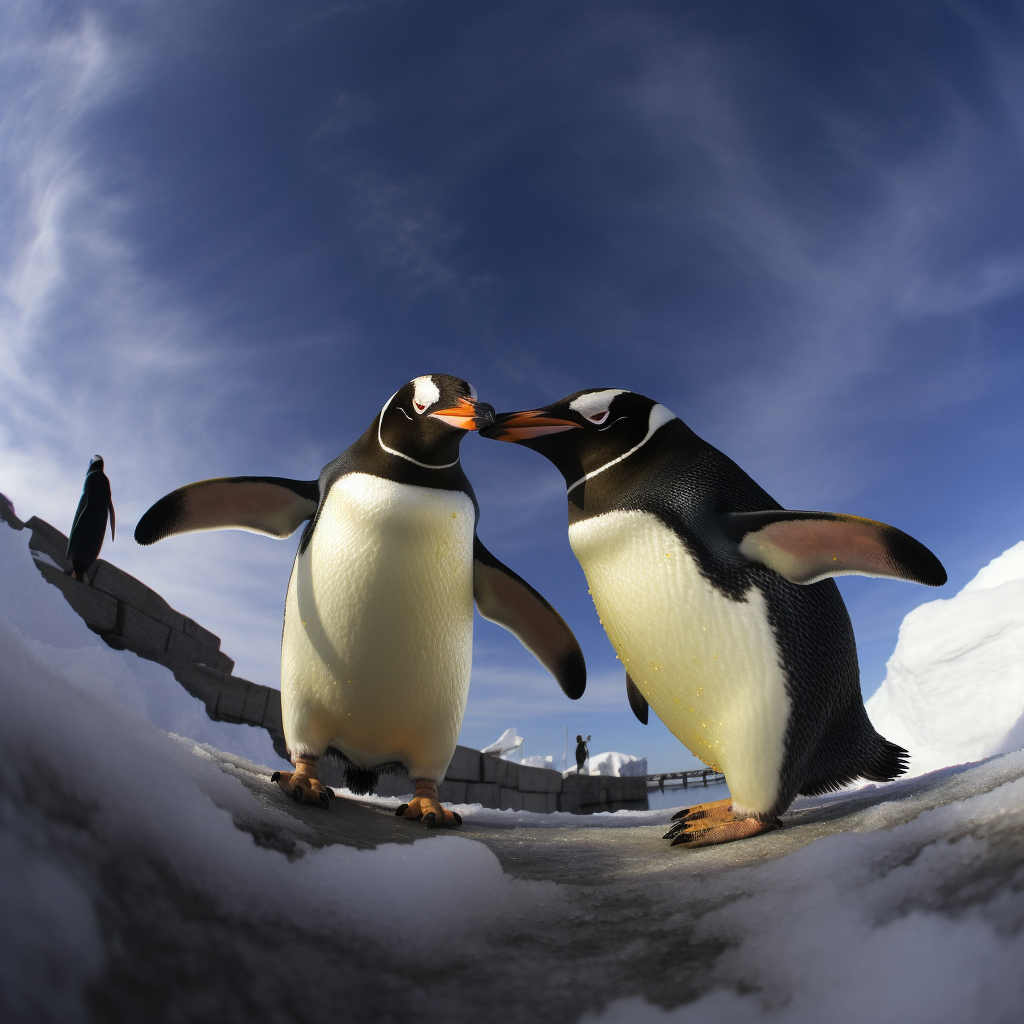Macaroni penguins, scientifically known as Eudyptes chrysolophus, are fascinating creatures that inhabit the cold and harsh environments of the sub-Antarctic regions. These charismatic birds have developed various strategies to protect themselves from predators and survive in their challenging surroundings. From their distinctive crests to their agile swimming abilities, macaroni penguins have evolved a range of adaptations that allow them to thrive in their unique habitat. In this article, we will explore the different ways in which macaroni penguins protect themselves, ensuring their survival in the face of adversity. So, let’s dive into the world of these remarkable birds and discover the secrets behind their self-defense mechanisms.
Key Takeaways
- Macaroni penguins protect themselves by forming large colonies, which provide safety in numbers and help deter predators.
- These penguins have sharp beaks and strong flippers that they use to defend themselves against threats.
- They also have a unique behavior called “ecstatic display” where they raise their heads, flap their flippers, and emit loud calls to intimidate predators.
- Macaroni penguins rely on their excellent swimming and diving abilities to escape from predators in the water.
- Conservation efforts are crucial to protect the habitats of macaroni penguins and ensure their long-term survival.
Understanding Macaroni Penguins: An Overview
A. Where Do Macaroni Penguins Live?
Macaroni penguins, scientifically known as Eudyptes chrysolophus, are a species of penguins that inhabit the sub-Antarctic and Antarctic regions. They are primarily found on the islands of the Southern Ocean, including South Georgia, the Falkland Islands, and the Kerguelen Islands. These birds are well-adapted to the harsh and icy environments of the Southern Hemisphere.
Macaroni penguins are known for their distinctive yellow crests on their heads, which resemble a macaroni pasta. They have black backs and white bellies, making them easily recognizable among other penguin species. These charismatic creatures are highly social and form large colonies, sometimes consisting of thousands of individuals.
B. How Do Macaroni Penguins Survive in Their Habitat?
Macaroni penguins have evolved several survival strategies to thrive in their challenging habitat. Let’s explore some of the ways these fascinating birds protect themselves and ensure their survival.
1. Penguin Colony Safety:
Macaroni penguins rely on the safety of their colonies to protect themselves from predators. By forming large groups, they create a collective defense mechanism that makes it difficult for predators to single out individual birds. This safety in numbers helps deter potential threats and increases the chances of survival for each penguin.
2. Penguin Predators and Threat Response:
While macaroni penguins face various predators, including leopard seals and killer whales, they have developed effective threat responses to avoid becoming prey. When a predator approaches, these penguins will emit loud calls to alert the rest of the colony. They will also gather in tightly packed groups, making it harder for predators to attack and increasing the chances of survival for the majority of the colony.
3. Penguin Adaptations and Natural Defenses:
Macaroni penguins have evolved physical adaptations that aid in their survival. Their streamlined bodies and strong flippers allow them to swim swiftly through the water, enabling them to escape from predators. Additionally, their dense feathers provide excellent insulation, keeping them warm in the frigid Antarctic waters.
4. Penguin Self-Defense and Predator Avoidance:
When faced with a potential threat, macaroni penguins may resort to self-defense mechanisms. They can use their sharp beaks and strong wings to peck or slap at predators, deterring them from attacking. These penguins are also agile swimmers, capable of diving deep into the water to evade predators.
5. Penguin Survival Skills and Protection Strategies:
Macaroni penguins exhibit remarkable survival skills. They have the ability to dive to great depths in search of food, reaching depths of up to 100 meters (330 feet). This skill allows them to access a wider range of prey and reduces competition for food within their colonies. By being resourceful and adaptable, macaroni penguins increase their chances of survival in their challenging environment.
In conclusion, macaroni penguins have developed various strategies to protect themselves and ensure their survival in the sub-Antarctic and Antarctic regions. From relying on the safety of their colonies to employing threat responses and physical adaptations, these charismatic birds have evolved to thrive in their icy habitat. By understanding their behaviors and unique characteristics, we can appreciate the remarkable resilience of these fascinating creatures.
The Defense Mechanisms of Macaroni Penguins

A. How Do Macaroni Penguins Protect Themselves?
Macaroni penguins, known for their distinctive yellow crests and vibrant red eyes, have developed various defense mechanisms to ensure their survival in the harsh Antarctic environment. These fascinating creatures employ a combination of physical adaptations, behavioral strategies, and social structures to protect themselves from potential threats.
1. Camouflage and Blending In
One of the primary ways macaroni penguins protect themselves is through their remarkable ability to blend in with their surroundings. Their black and white plumage helps them camouflage against the icy landscape, making it difficult for predators to spot them. By blending in, these penguins can avoid becoming easy targets for predators such as leopard seals and orcas.
2. Safety in Numbers: Penguin Colonies
Macaroni penguins are highly social animals and form large colonies, consisting of thousands of individuals. This collective behavior provides them with an added layer of protection against predators. By huddling together in large groups, these penguins create a formidable presence that deters potential threats. Predators are less likely to attack a large group of penguins compared to a solitary individual.
3. Vigilance and Alarm Calls
Within the penguin colonies, individuals take turns acting as sentinels, keeping a watchful eye for any signs of danger. These sentinels stand on elevated positions, such as rocks or icebergs, scanning the surroundings for predators. If they spot a threat, they emit loud alarm calls to alert the rest of the colony. This early warning system allows the penguins to quickly respond and take evasive action.
4. Speed and Agility
When faced with an immediate threat, macaroni penguins rely on their speed and agility to escape. They are excellent swimmers and can reach speeds of up to 20 miles per hour (32 kilometers per hour) in the water. This enables them to quickly evade predators that may be pursuing them. On land, although not as nimble as in the water, they can still waddle away from danger with surprising speed.
5. Nest Defense and Aggressive Displays
During the breeding season, macaroni penguins fiercely defend their nests and territories. They engage in aggressive displays, such as flapping their flippers, bowing their heads, and emitting loud calls. These displays serve as warning signals to potential intruders, indicating that the penguin is ready to defend its space. By displaying aggression, macaroni penguins deter other penguins or predators from encroaching on their nesting sites.
B. How Do Macaroni Penguins Protect Themselves from Predators?
While macaroni penguins have developed several general defense mechanisms, they also employ specific strategies to protect themselves from their natural predators in the Antarctic ecosystem.
1. Predator Avoidance
Macaroni penguins have evolved to recognize and avoid potential predators. They are particularly vigilant when entering and exiting the water, as this is when they are most vulnerable to attacks from leopard seals and orcas. Before diving into the water, they often scan the surroundings for any signs of danger. By being cautious and aware of their surroundings, they can minimize the risk of encountering predators.
2. Group Defense
When a predator approaches a macaroni penguin colony, the entire group springs into action. The penguins will form a defensive line, with the adults positioned on the outer edges and the chicks in the center. This formation provides the chicks with additional protection, as the adults shield them from potential threats. By working together, the penguins increase their chances of survival and reduce the likelihood of any individual being targeted by a predator.
3. Dive and Swim
When pursued by a predator, macaroni penguins have the ability to dive into the water and swim away. Their streamlined bodies and strong flippers allow them to navigate through the water with agility, making it challenging for predators to catch them. By utilizing their natural swimming abilities, macaroni penguins can escape from dangerous situations and seek safety in the ocean.
In conclusion, macaroni penguins have developed a range of defense mechanisms to protect themselves from predators and ensure their survival in the Antarctic environment. Through camouflage, group behavior, vigilance, speed, aggression, and specific predator avoidance strategies, these remarkable creatures have adapted to thrive in their challenging habitat. By understanding and appreciating these defense mechanisms, we can gain a deeper insight into the fascinating world of macaroni penguins and the remarkable ways they protect themselves.
The Art of Foraging: How Macaroni Penguins Get Their Food
Macaroni penguins are fascinating creatures that have developed unique hunting techniques and physical attributes to help them gather food in their icy Antarctic habitat. Let’s take a closer look at how these remarkable birds navigate the challenges of finding sustenance in their environment.
A. Hunting Techniques of Macaroni Penguins
Macaroni penguins are skilled hunters, employing various techniques to secure their meals. Here are some of the strategies they use:
-
Group Hunting: Macaroni penguins often hunt in groups, known as colonies, which can consist of thousands of individuals. This cooperative behavior helps them increase their chances of success by creating a larger presence that can overwhelm potential prey.
-
Diving: These penguins are excellent divers, capable of reaching depths of up to 100 meters (328 feet) in search of food. They use their streamlined bodies and strong flippers to propel themselves underwater, where they can stay submerged for several minutes at a time.
-
Feeding Frenzies: When a group of macaroni penguins locates a school of fish or krill, they engage in feeding frenzies. This involves diving and swimming rapidly, using their sharp beaks to snatch up as much prey as possible. It’s an impressive sight to witness these agile birds maneuvering through the water with such precision.
-
Filter Feeding: Macaroni penguins primarily feed on krill, a tiny shrimp-like crustacean that forms the basis of their diet. To capture these small organisms, the penguins employ a technique called filter feeding. They open their beaks wide and swim through dense swarms of krill, filtering out the tiny creatures with specialized bristles on their tongues.
B. The Role of Their Physical Attributes in Food Gathering
Macaroni penguins possess several physical attributes that aid them in their quest for food. These adaptations have evolved over time to enhance their hunting abilities. Here are some notable features:
-
Sleek Body Shape: Macaroni penguins have a streamlined body shape, which reduces drag and allows them to swim swiftly through the water. This streamlined form enables them to pursue prey more effectively and cover greater distances while expending less energy.
-
Webbed Feet: Their webbed feet serve as powerful paddles, enabling macaroni penguins to propel themselves through the water with ease. This adaptation allows them to navigate their marine environment efficiently and chase after their prey.
-
Sharp Beak: The beak of a macaroni penguin is long, slender, and pointed, ideal for capturing and grasping small prey. With their sharp beaks, these birds can snatch up krill and other small organisms swiftly and efficiently.
-
Excellent Eyesight: Macaroni penguins have exceptional eyesight both in and out of the water. This keen vision helps them spot schools of fish or krill from a distance, allowing them to locate potential food sources more effectively.
In conclusion, macaroni penguins have honed their hunting techniques and physical attributes to thrive in their Antarctic habitat. Their group hunting behavior, diving skills, and filter feeding techniques enable them to secure the sustenance they need to survive. Additionally, their sleek body shape, webbed feet, sharp beaks, and excellent eyesight all contribute to their success as skilled hunters. By understanding how these fascinating creatures gather their food, we can gain a deeper appreciation for their remarkable adaptations and the challenges they face in their icy home.
The Importance of Egg Protection in Macaroni Penguins

A. How Do Penguins Protect Their Eggs?
Macaroni penguins, like other penguin species, have evolved various strategies to protect their precious eggs. These remarkable birds understand the importance of safeguarding their offspring, as their survival depends on it. Let’s explore some of the ways in which macaroni penguins protect their eggs.
1. Incubation Behavior
One of the primary methods employed by macaroni penguins to protect their eggs is through incubation behavior. After laying their eggs, both the male and female penguins take turns incubating them. This shared responsibility ensures that the eggs are constantly kept warm and protected from the harsh Antarctic environment.
During incubation, the penguins carefully position their eggs on top of their feet and cover them with a warm layer of feathers known as the brood patch. This patch of bare skin allows for direct contact between the egg and the parent’s warm body, providing optimal conditions for development.
2. Nest Building
Macaroni penguins are meticulous nest builders. They use pebbles and rocks to construct circular nests, which serve as a protective barrier for their eggs. These nests elevate the eggs above the cold ground, reducing the risk of exposure to low temperatures and potential predators.
By building nests, macaroni penguins create a safe and secure environment for their eggs. The nests also help to prevent the eggs from rolling away, ensuring they remain in a stable position throughout the incubation period.
B. The Role of Parental Care in Egg Protection
Parental care plays a crucial role in the protection of macaroni penguin eggs. Both the male and female penguins actively participate in the incubation process and work together to ensure the safety of their offspring.
1. Shared Incubation
Macaroni penguins exhibit a unique behavior known as shared incubation. This means that both parents take turns incubating the eggs, allowing each penguin to forage for food and replenish their energy reserves. By sharing this responsibility, the penguins minimize the risk of leaving the eggs unattended for extended periods.
2. Vigilance against Predators
While one parent is incubating the eggs, the other stands guard, keeping a watchful eye for potential predators. Macaroni penguins face threats from predators such as skuas, giant petrels, and leopard seals. These vigilant parents will emit loud calls to alert their partner and other nearby penguins of any approaching danger.
3. Teamwork and Communication
Effective communication and teamwork are essential for macaroni penguins to protect their eggs successfully. They use a combination of vocalizations, body postures, and visual cues to communicate with their partner and coordinate their actions. This synchronized effort ensures that both parents are always aware of their surroundings and can respond quickly to any potential threats.
In conclusion, macaroni penguins employ a range of strategies to protect their eggs and ensure the survival of their offspring. Through incubation behavior, nest building, shared incubation, vigilance against predators, and effective communication, these remarkable birds demonstrate their commitment to safeguarding their future generations. By understanding the importance of egg protection, macaroni penguins have adapted to thrive in the challenging Antarctic environment.
The Significance of Protecting Penguins

Penguins are fascinating creatures that inhabit the icy landscapes of the Southern Hemisphere, particularly in Antarctica. These flightless birds have captivated the hearts of many people around the world with their adorable waddle and distinctive appearance. However, beyond their charm, it is crucial to understand why it is important to protect penguins and the impact of human activities on their survival.
A. Why Is It Important to Protect Penguins?
Penguins play a vital role in maintaining the delicate balance of the Antarctic ecosystem. As a keystone species, they have a significant impact on the food web and serve as indicators of the overall health of the environment. By protecting penguins, we are indirectly safeguarding the entire Antarctic ecosystem.
-
Biodiversity: Penguins contribute to the rich biodiversity of the region. Their presence supports a diverse range of species, including krill, fish, and seals, which rely on penguins as a food source. Protecting penguins ensures the survival of these interconnected species.
-
Ecosystem Stability: Penguins are known to be excellent swimmers and divers, allowing them to forage for food in the ocean. Their feeding habits help regulate the population of fish and krill, preventing overconsumption and maintaining a balanced ecosystem.
-
Research and Education: Studying penguins provides valuable insights into various scientific fields, such as ecology, marine biology, and climate change. By protecting penguins, we enable researchers to gather data that can aid in understanding the effects of environmental changes on these remarkable creatures and the broader ecosystem.
B. The Impact of Human Activities on Penguin Survival
Unfortunately, human activities have posed significant threats to penguins and their habitats. It is essential to recognize the consequences of our actions and work towards minimizing these impacts to ensure the long-term survival of penguin populations.
-
Climate Change: The warming of the planet due to human-induced climate change has resulted in the loss of sea ice, which is crucial for penguins’ breeding and foraging activities. As their habitat diminishes, penguins face challenges in finding food and establishing stable colonies.
-
Overfishing: Penguins heavily rely on the availability of fish and krill to sustain themselves and feed their chicks. Overfishing disrupts the delicate balance of the food chain, depleting the resources that penguins depend on for survival.
-
Pollution: Pollution, particularly marine pollution, poses a significant threat to penguins. Oil spills, plastic debris, and chemical contaminants can contaminate their food sources and negatively impact their health. It is crucial to reduce pollution and promote responsible waste management to protect penguins and their habitats.
-
Disturbance and Habitat Destruction: Human presence, tourism, and development in penguin habitats can cause disturbance and habitat destruction. Nesting sites can be disrupted, leading to abandonment of eggs or chicks. It is essential to establish guidelines and regulations to minimize human interference and protect penguin breeding grounds.
In conclusion, protecting penguins is of utmost importance for the preservation of the Antarctic ecosystem. By understanding the significance of their role and the impact of human activities, we can take proactive measures to ensure the survival of these remarkable birds. Through conservation efforts, research, and education, we can create a sustainable future for penguins and the entire Antarctic wildlife. Conclusion
In conclusion, Macaroni Penguins have developed several fascinating adaptations to protect themselves from predators and harsh environmental conditions. Their distinctive crests and bright yellow eyebrows not only serve as unique identifiers but also play a crucial role in attracting mates. These penguins form large colonies, which provide safety in numbers and allow for efficient communication. They also rely on their excellent swimming and diving abilities to escape from predators in the water. On land, Macaroni Penguins build their nests in rocky areas, providing them with natural protection and camouflage. Additionally, their aggressive behavior and loud calls help deter potential threats. Overall, Macaroni Penguins have evolved a combination of physical, behavioral, and social strategies to ensure their survival in the challenging Antarctic environment.
Frequently Asked Questions
How do macaroni penguins defend themselves?
Macaroni penguins use a combination of physical attributes and behaviors for self-defense. They are excellent swimmers, which helps them to escape from predators in the water. On land, they rely on their sharp beaks and flippers to fend off threats. They also live in large colonies, which provide safety in numbers.
How do macaroni penguins get their food?
Macaroni penguins are adept swimmers and divers, using these skills to hunt for their food. They primarily feed on small fish, squid, and krill. They can dive up to 100 meters deep and stay underwater for several minutes in pursuit of their prey.
Why is it important to protect penguins?
Penguins play a crucial role in maintaining the health of the marine ecosystem. They help control the population of their prey, contribute to nutrient cycling through their guano, and their population trends can indicate changes in the environment. Protecting penguins also helps preserve biodiversity in the Antarctic region.
How do penguins protect their eggs?
Penguins protect their eggs by incubating them on their feet, covered by a warm layer of abdominal skin called a brood pouch. This keeps the eggs off the icy ground and away from predators. Both parents take turns incubating the eggs while the other goes out to feed.
How do macaroni penguins survive?
Macaroni penguins survive using a combination of their physical adaptations and behaviors. They are excellent swimmers and divers, which allows them to hunt for food. They also have a thick layer of insulating feathers to protect them from the cold. Living in large colonies also provides protection from predators.
How do macaroni penguins protect themselves from predators?
Macaroni penguins protect themselves from predators by living in large colonies, which can deter predators. In the water, they are agile swimmers and can quickly dive to escape threats. On land, they can use their beaks and flippers to defend themselves.
Where do macaroni penguins live?
Macaroni penguins are native to the Antarctic and sub-Antarctic regions. They breed on rocky, cliff-bound islands in the Southern Ocean, particularly in the South Sandwich Islands, South Orkney Islands, and the South Shetland Islands.
How do macaroni penguins protect themselves from predators?
Macaroni penguins have several defense mechanisms against predators. In the water, they can swim at high speeds and change direction quickly to evade predators. On land, they live in large colonies and use their beaks and flippers for defense.
What are the main threats to macaroni penguins?
The main threats to macaroni penguins include climate change, overfishing, and habitat disturbance. Climate change affects the availability of their food sources, while overfishing reduces their food supply. Habitat disturbance, particularly human activity in their breeding areas, can also pose a threat.
What are the characteristics of macaroni penguins?
Macaroni penguins are medium-sized penguins, with a distinctive crest of yellow and black feathers on their heads. They have black backs and white bellies, with a black chin and face. They are known for their loud, braying call, and are one of the most abundant species of penguins.




